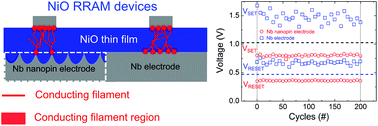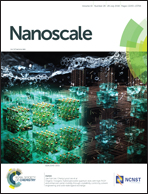Effects of a Nb nanopin electrode on the resistive random-access memory switching characteristics of NiO thin films
Abstract
We report the effects of bottom electrode shapes on resistive random-access memory (RRAM) devices composed of Nb (bottom electrode)/NiO (dielectric)/Nb (top electrode) structures. By adopting a nano-fabrication process using an anodic aluminum oxide (AAO) nanotemplate, a well-aligned Nb nanopin array bottom electrode was formed on the surface of a Si substrate. For comparison, a Nb thin film was employed as a different type of bottom electrode. Then, a NiO thin film dielectric was prepared on both the Nb bottom electrodes via a spin coating method, followed by Nb sputtering for the Nb top electrode. Both the RRAM devices with Nb nanopin and thin film bottom electrodes exhibited typical unipolar resistive switching behavior. However, a lower SET/RESET voltage was observed for the Nb nanopin electrode compared to the Nb thin film electrode by virtue of an enhanced electric field induced by the nanopin-shaped electrode. More significantly, on the basis of endurance and retention characteristics, the Nb nanopin electrode played a key role in minimizing the dispersion of the low- and high-resistance state currents and the variation in the SET/RESET voltage by developing more-concise conducting filaments in the conducting path. Therefore, we foresee that this approach can provide an insight into the optimal design of RRAM devices.



 Please wait while we load your content...
Please wait while we load your content...